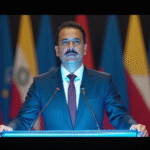Background on Key Figures and Context
The G7 summit in Kananaskis, Canada, was abruptly disrupted when U.S. President Donald Trump left early due to escalating tensions between Israel and Iran. This move has sparked global concern, especially after Trump’s urgent call for the evacuation of Tehran via his social media platform.
Who are the key figures?
- Donald Trump: The 45th President of the United States, known for his unconventional approach to international relations.
- Benjamin Netanyahu: The Prime Minister of Israel, who has been vocal about his country’s military actions against Iran.
- Ali Khamenei: The Supreme Leader of Iran, who denies his country’s pursuit of nuclear weapons and insists on its right to a civilian nuclear program.
Summary of Key Events
- Trump’s Early Departure: Trump left the G7 summit in Canada a day earlier than planned, citing the crisis between Israel and Iran as the reason.
- Evacuation Call for Tehran: Trump used his social media platform to urge an immediate evacuation of Tehran, a city with over 10 million inhabitants.
- Netanyahu’s Threats: Israel’s Prime Minister Netanyahu issued threats against Iran, describing the conflict as a “battle of civilization against barbarism” and comparing Iran’s leader to a “modern-day Hitler.”
- Israeli Attacks on Iran: Israel launched military strikes targeting Iranian military and nuclear facilities, including the Natanz enrichment center. Despite some surface destruction, the underground facilities remained intact.
- Iranian Retaliation: Iran responded by launching missiles at various Israeli cities, resulting in multiple casualties and significant property damage.
Impact on Tehran and Israel
Tehran experienced a ghostly atmosphere on Monday, with most businesses closed and long queues forming at gas stations. Israel, on the other hand, reported at least 11 fatalities from Iranian missile strikes across several cities.
Nuclear Concerns
Both Israel and Western powers accuse Iran of pursuing nuclear weapons, a claim denied by Iran, which asserts its right to a civilian nuclear program. The recent Israeli attacks targeted Iran’s enrichment facilities, but the underground components remained unscathed according to the International Atomic Energy Agency (IAEA).
Media Targeting
Israel’s military strikes also targeted Iran’s state-run television and radio buildings, disrupting live broadcasts. Despite the attacks, Iranian media resumed transmissions, emphasizing their commitment to continuing their revolutionary voice.
Key Questions and Answers
- Q: Why did Trump leave the G7 summit early? A: Trump cited escalating tensions between Israel and Iran as the reason for his premature departure from the G7 summit in Canada.
- Q: What did Trump’s evacuation call for Tehran entail? A: Trump urged an immediate evacuation of Tehran via his social media platform, raising global alarm due to the city’s large population.
- Q: How has Iran responded to Israeli military actions? A: Iran retaliated by launching missiles at various Israeli cities, causing casualties and property damage.
- Q: What is the status of Iran’s nuclear program amidst these tensions? A: Despite accusations from Israel and Western powers, Iran maintains its nuclear program is for civilian purposes. Recent Israeli strikes only partially affected Iran’s nuclear facilities, as per the IAEA.






